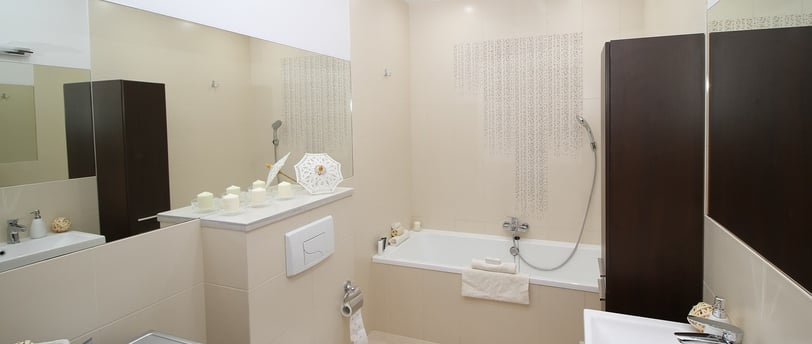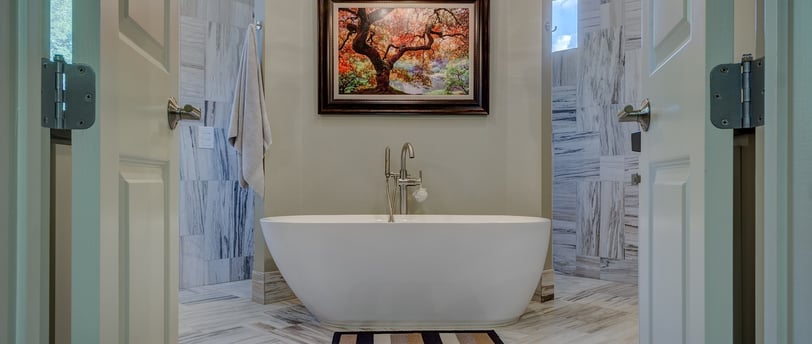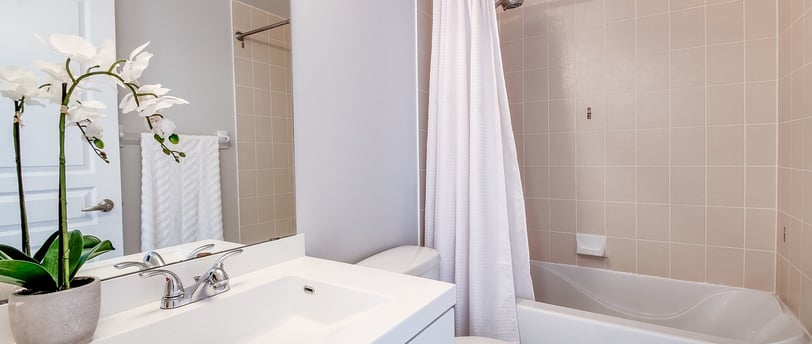Bathroom Remodel Ideas
New Bathroom Remodel Ideas for Modern and Efficient Spaces. Bathroom remodel ideas range from simple updates to full renovations that transform both style and function.
HOME COMFORT


Decorative Storage Solutions
Decorative storage combines practicality with aesthetic appeal to reduce clutter. Open shelving made of natural wood adds warmth while displaying towels or curated accessories.
Built-in niches with contrasting tile linings offer concealed storage in showers or near bathtubs. Woven baskets or ceramic jars are attractive holders for toiletries.
Vanity drawers equipped with organizers optimize space and keep essentials accessible. Incorporating pull-out trays or hidden compartments helps maintain a clean surface.
Sustainable and Smart Bathroom Ideas
A bathroom can be both eco-friendly and efficient by focusing on water-saving fixtures, responsible material choices, and the integration of intelligent technology. These elements reduce resource use while enhancing convenience.
Water-Efficient Fixtures
Water-efficient fixtures limit consumption without compromising functionality. Low-flow toilets use about 1.28 gallons per flush compared to older models using up to 3.5 gallons. Dual-flush toilets allow users to select different flush volumes, saving water based on waste type.
Faucets and showerheads with aerators reduce flow rates to around 1.5 gallons per minute while maintaining pressure. Motion sensors or touchless controls prevent water waste by automatically shutting off.
Installing these fixtures can significantly lower water bills and reduce environmental impact without any noticeable change in daily use.
Eco-Friendly Materials
Using sustainable materials in a bathroom minimizes environmental harm and promotes durability. Bamboo and reclaimed wood offer renewable options for vanities and storage.
Tiles made from recycled glass or porcelain reduce landfill waste and have a smaller carbon footprint. Low-VOC (volatile organic compounds) paints improve indoor air quality by reducing harmful emissions.
Moisture-resistant materials like stone or ceramic prolong the life of the remodel and limit the need for frequent replacement, supporting sustainability over time.
Smart Technology Integration
Smart devices optimize bathroom functions and increase energy and water efficiency. Digital shower controls can preset temperature and flow settings, reducing water waste.
Smart mirrors may include lighting adjustments and anti-fog features activated by sensors, enhancing user experience while using less electricity.
Water leak detectors connected to home networks alert homeowners immediately, preventing damage and unnecessary water loss. Combined, these technologies offer precise control and monitoring for a modern, sustainable bathroom.


Bathroom Remodel Ideas for Modern and Efficient Spaces
Bathroom remodel ideas range from simple updates to full renovations that transform both style and function. Many focus on modern fixtures, improved storage, and efficient layouts to create a more comfortable and practical space. Selecting durable materials and incorporating smart storage solutions are key to a successful bathroom remodel.
Upgrading lighting and ventilation often enhances the overall atmosphere and usability. People also consider adding features like walk-in showers, freestanding tubs, and updated vanities to boost both appeal and convenience.
By combining aesthetics with functionality, a bathroom remodel can increase home value while meeting everyday needs. These ideas serve as a practical guide for anyone ready to refresh their bathroom thoughtfully.
Modern Bathroom Remodel Ideas
Modern bathroom designs focus on efficiency, style, and simplicity. Key aspects include maximizing space, using updated color palettes, and selecting sleek fixtures that reduce clutter while enhancing functionality.


Space-Saving Layouts
Smart layouts make the most of limited square footage. Installing corner sinks or wall-mounted vanities frees floor space and improves movement. Niches built into shower walls serve as storage without encroaching on the room.
Sliding or pocket doors replace traditional swing doors to save floor area. Combining bathtub and shower units can also reduce the footprint without sacrificing comfort. Clear glass shower enclosures maintain openness and allow light to flow through the room.
Contemporary Color Schemes
Modern bathrooms often use neutral or muted colors to achieve a calm atmosphere. Shades like soft gray, beige, and white create a clean backdrop that works well with natural materials such as wood or stone.
Accent colors appear in towels, plants, or wall art instead of large surfaces. Matte finishes and subtle contrasts prevent glare and add a sophisticated touch without overwhelming the senses.
Minimalist Fixtures
Fixtures prioritize function and minimal design. Wall-mounted faucets and toilets with concealed tanks keep surfaces clear. Simple, geometric shapes dominate in modern taps, showerheads, and hardware.
Integrated lighting within mirrors or cabinets reduces the need for bulky light fixtures. Focus lies on durability and easy maintenance, with materials like stainless steel and tempered glass favored for longevity.
Popular Features for Bathroom Upgrades
Many bathroom remodels focus on enhancing comfort, style, and function. Key features include efficient shower designs, elegant tubs, and personalized storage solutions.
Walk-In Showers
Walk-in showers are preferred for accessibility and space optimization. They often have frameless glass doors or no doors at all. This design minimizes barriers and creates an open, airy feel.
Tile choices vary widely, with large-format tiles or mosaics improving both aesthetics and grip. Multiple shower heads or body sprays add luxury and improve water coverage. Built-in benches and niches provide convenience and organization without crowding the space.
Drain placement is also important; linear drains allow for seamless tiling and better water flow. Proper waterproofing ensures durability and prevents leaks. Walk-in showers suit small and large bathrooms, adapting well to modern and traditional styles.
Freestanding Bathtubs
Freestanding bathtubs elevate a bathroom’s visual appeal while offering a comfortable soaking experience. Common materials include acrylic and cast iron, each with different heat retention and weight.
These tubs require sufficient floor space and often serve as a focal point. Styling ranges from modern minimalist to vintage clawfoot designs. Placement is flexible but often centered under a window or away from walls for visual impact.
Freestanding tubs also need floor reinforcement and appropriate plumbing setup. Their deeper design allows full body immersion, making them ideal for relaxation. Maintenance focuses on cleaning exterior surfaces, as they are accessible from all sides. (Bathroom mirror ideas)
Custom Vanities
Custom vanities offer tailored storage and design options. They maximize available space while matching personal style preferences. Materials often include hardwood, MDF, or plywood with a variety of finishes.
Countertops are made from quartz, marble, granite, or engineered stone, chosen for durability and appearance. Storage solutions like drawers, cabinets, and open shelving help keep essentials organized.
Features such as integrated lighting, soft-close drawers, and built-in outlets add functionality. Custom sizing and configuration allow vanities to fit awkward spaces or provide dual sinks. They improve both utility and the overall bathroom aesthetic.
Creative Design Details
Incorporating unique design elements can transform a standard bathroom into a distinctive space. Small choices in texture, color, and function add personality while improving usability.
Bold Tile Patterns
Using bold tile patterns can create a focal point and add visual interest to the bathroom. Geometric shapes, encaustic motifs, or large-scale florals work well on floors or as accent walls.
Mixing colors like deep navy with white or soft grays highlights the pattern without overwhelming the room. Matte and glossy finishes combined in a single design offer subtle texture contrasts.
For smaller bathrooms, placing patterned tiles on one wall or inside a shower niche balances style with spatial flow. Grout color also plays a role; darker grout emphasizes tile shapes, while light grout softens the effect.
Statement Lighting
Statement lighting boosts both style and functionality in a bathroom. Oversized pendants or sculptural sconces over the vanity provide bright, even illumination and serve as decor highlights.
Layered lighting with dimmable options helps adjust mood and practicality. Warm LED bulbs mimic natural light, enhancing skin tones and color accuracy for grooming tasks.
Metal finishes like brass, black matte, or brushed nickel complement various styles, from modern to traditional. Positioning lights at face level reduces shadows, aiding daily routines.
